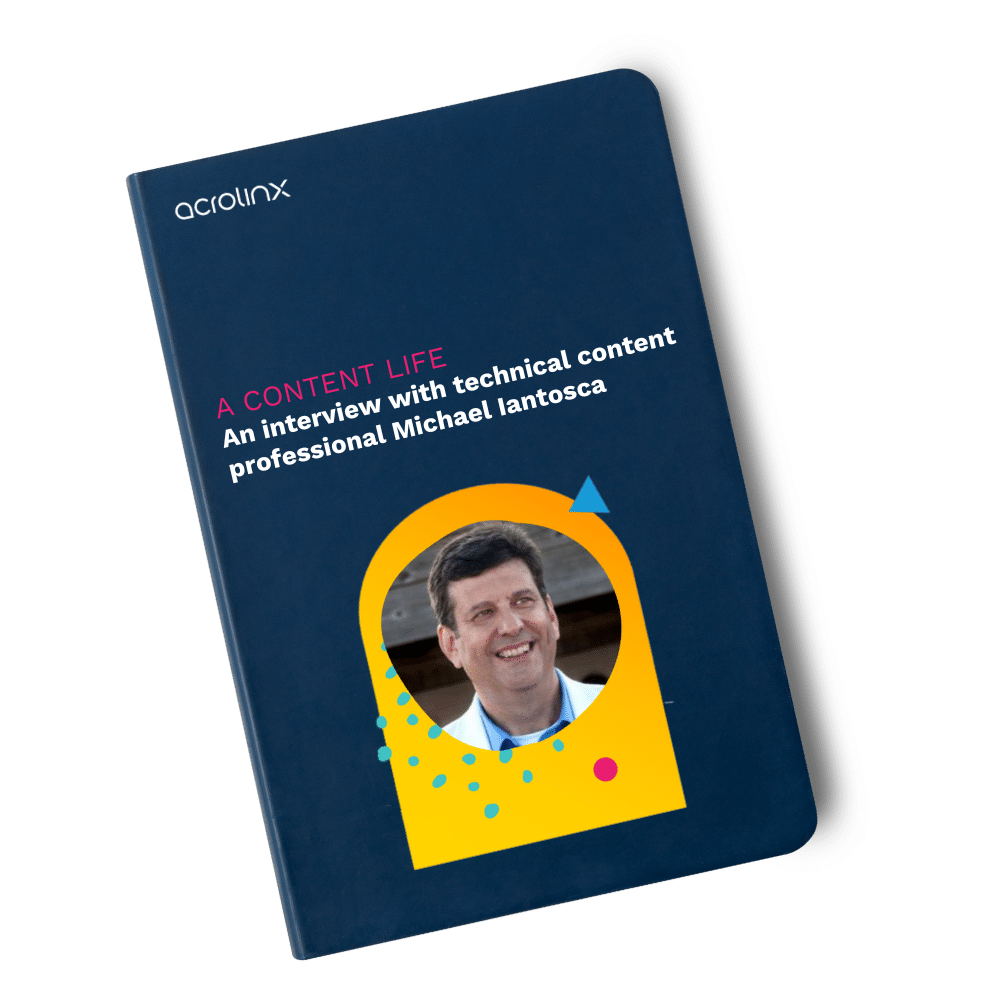The “Content Hall of Fame” Series: An Interview with Technical Content Professional Michael Iantosca

Image: © 2021 Michael J Iantosca
At age 12, Michael (Mike) Iantosca developed and printed his first roll of film. That started a lifelong interest in photography, and one might say, indirectly led him to an illustrious career in technical content. It’s true (although perhaps we’re slightly biased) that Mike is a bit of a “content superstar” — attributed partly to the fact that without Mike’s contributions, the world of DITA content might not exist.
After four decades of a career in the world of technology and content, you’d forgive Mike Iantosca for looking forward to retirement. As it turns out, Mike’s energy and passion for solving complex content problems is stronger than ever. He recently started a new chapter as a Senior Director of Content Platforms at Avalara, helping to build a state-of-the-art intelligent content supply chain to help the leader in business tax compliance software manage its stellar growth. We asked Mike to share his enriching insights into the world of content creation and management.
This blog is a sneak peak into the full length interview, that you can download to receive even more content wisdom! We hope that his reflections, achievements, challenges, tools, and mindsets are useful to our readers. Mike dives into:
- How content has evolved over his career.
- What the goals of technical/product content should be.
- What the content supply chain is.
- Why intelligent content delivery is the future of content.
- Why it took marketing so long to recognize the value of modular content.
- What advice he would give to new content creators beginning their career.
DITA was originally developed within the technical publications department at IBM. How did you contribute to the creation and implementation of DITA as we know it?
DITA almost didn’t happen. I was present at the Standardized General Mark-up Language (SGML) ’97 conference in Boston where the XML 1.0 specification was announced with great fanfare on stage by the likes of Jean Paoli, Jon Bosak, and Tim Bray.
When I returned from the SGML ’97 conference, I immediately began to evangelize XML throughout IBM. I published an extensive white paper about XML that was widely circulated internally and I presented to then CEO Louis Gerstner, in person. I was convinced that the next generation of our publishing platform needed to be based on XML.
I consider two of my colleagues, Michael Priestley and Don Day, as the thought leaders and primary inventors of DITA. I built the new platform to put DITA into production. A few years later, DITA became the most successful OASIS standard in history. Had I not prevailed and formed the workgroup that created DITA, the entire industry as we know it might not exist.
- In your blog, on your website you say that for roughly 20 years, you “led the development of multiple generations of structured content management systems and supply chain at IBM.” I’m not sure all of our readers have an intuitive understanding of what a content supply chain is. Could you explain it briefly?
A supply chain comprises an entire ecosystem of content, standards, and technology that forms the end-to-end content lifecycle. A content supply chain treats content as a utility — where content is electricity and the technology is the grid. Some call it Content as a Service (CaaS), but it’s more than that…
- The concept of modular content is fairly new outside of technical documentation. Marketing teams are just starting to see the benefits of modular content creation. What took them so long?
Many organizations viewed content as an expense — a necessary evil as opposed to being the competitive asset that it actually is. Content, even post-sales technical content, is a major conduit to sales and revenue. Most sales begin with subject matter experts researching prospective technology long before they contact a sales rep.
Another “AhHa!” moment happens when business leaders learn that content needs to be personalized, now that it replaces a large swath of direct selling. Big, monolithic, one-size-fits-all content can’t get that done.
- What should the goals of technical/software documentation be? In other words, what should it seek to do? What should it not do?
The most fundamental goal is to maximize the time-to-value proposition for customers. The way to delight customers is to help them achieve maximum value in the shortest amount of time with the least friction — revenue and profits then follow.
I see two modes of content. The historic mode is what we labeled “failure-mode” content. The technical documentation was used mostly as a fall-back when the customer had a problem. The second, forward-looking mode is proactive and assistive content.
The gulf between failure mode content and proactive/assistive content has been a difficult one to cross, but many are beginning to make significant headway by using “intelligent content.” Intelligent content is modular, structured, and reusable. It separates format from presentation, and is semantically enriched, making it highly predictable for machine processing and automation.
- How can intelligent content delivery modules be applied to product documentation?
I’m most excited about moving from intelligent content to cognitive content. Countless companies have moved, or are in the process of moving, from monolithic and static content models to component-based, dynamic models. For that you need modular content.
- When did you first become aware of Acrolinx and what was it about Acrolinx that stood out to you?
When I learned about Acrolinx in the mid-2000s, I immediately jumped to learn more. As the IBM technical content tools lead, I was under extreme pressure from the IBM editorial leads — some 125 of them at the time, for some assistive technology for editors. Up to that point, we provided very little tooling for human editors.
We deployed Acrolinx to virtually every organization in the enterprise that produced customer-facing content and also to several internal-facing content teams. We began using Acrolinx to check product technical documentation, then expanded to include marketing, sales, developer support, partner support, learning, technical support, and many more.
At its height, we had 5000 content creators using Acrolinx, 15 harmonized and well-governed style guides, and an enterprise terminology corpus consisting of 1.5 million multilingual terms. Using Acrolinx, we were able to drive measurable content quality up from scores in the low 60s to the high 80s on average — and that was mostly on content previously edited by professional editors.
- To any technical writers or content writers at the beginning of their career, what advice would you give them to be better writers?
You might be surprised that I don’t immediately dive straight for some advanced technology, strategy, or methodology, but at my core I’ll always be a writer first and foremost.
There are three basic axioms that are as old as the hills of which we must never lose sight, even as we lurch towards the age of cognitive content, AI, and machine learning — even for new technical writers.
- Know your audience.
- You can’t not communicate.
- Recognize and immediately document your perplexities.
As we forge ahead into the era of cognitive content, these three points remain as fundamental and essential as ever. Beyond these are the best practices of minimalism, progressive disclosure, and task-oriented writing, which are all staples of the profession.
Finally, as content professionals, we’re constantly both students and teachers. In our zeal to assimilate complex subject matter to communicate with others, we must remain ever-vigilant to not dismiss what we find initially confusing.
Moving ahead, we have to progress beyond intelligent content. Many have only gone half the distance in the content marathon. The next frontier requires knowledge of intelligent content assets that complement intelligent content. Intelligent knowledge assets include taxonomies, ontologies, knowledge graphs, computational linguistics, AI, and machine learning to name a few.
These are the building blocks of the next generation of content and user assistance — and many are already behind. Great tools help create great content, and the use of platforms like Acrolinx are going to play a central and essential role in building that future.
Learn more from Mike in A Content Life: An interview with technical content professional Michael Iantosca.
Are you ready to create more content faster?
Schedule a demo to see how content governance and AI guardrails will drastically improve content quality, compliance, and efficiency.

Kiana Minkie
She comes to her content career from a science background and a love of storytelling. Committed to the power of intentional communication to create social change, Kiana has published a plethora of B2B content on the importance of inclusive language in the workplace. Kiana, along with the Acrolinx Marketing Team, won a Silver Stevie Award at the 18th Annual International Business Awards® for Marketing Department of the Year. She also started the Acrolinx Diversity and Inclusion committee, and is a driving force behind employee-driven inclusion efforts.





